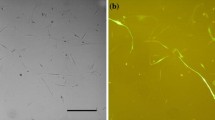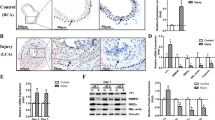Summary
Lipoma preferred partner (LPP) has been identified as a protein which is highly selective for smooth muscle progenitor cells (SMPCs) and regulates differentiation and migration of SMPCs, but mechanisms of LPP expression are not elucidated clearly. The aim of the present study was to discuss the mechanisms by which LPP expression is regulated in the differentiation and migration of SMPCs induced by TGF-β1. It was found that TGF-β1 could significantly increase the expression of LPP, smooth muscle α-actin, smooth muscle myosin heavy chain (SM-MHC), and smoothelin in SMPCs. Moreover, inactivation of Rho kinase (ROK) with ROK inhibitors significantly inhibited LPP mRNA expression in TGF-β1-treated SMPCs and mouse aortic smooth muscle cells (MAoSMCs). At the same time, LPP silencing with short interfering RNA significantly decreased SMPCs migration. In conclusion, LPP appears to be a ROK-dependant SMPCs differentiation marker that plays a role in regulating SMPCs migration.
Similar content being viewed by others
References
Sinha S, Hoofnagle MH, Kingston PA, et al. Transforming growth factor-beta1 signaling contributes to development of smooth muscle cells from embryonic stem cells. Am J Physiol Cell Physiol, 2004, 287(6):1560–1568
Bjorkerud S. Effects of transforming growth factor-beta 1 on human arterial smooth muscle cells in vitro. Arterioscler Thromb, 1991,11(4):892–902
Hautmann MB, Madsen CS, Owens GK. A transforming growth factor TGF-β1 control element drives TGF-β1 induced stimulation of smooth muscle α-actin gene expression in concert with two CArG elements. J Biol Chem, 1997,272(16):10 948–10 956
Suwanabol PA, Kent KC, Liu B. TGF-β and restenosis revisited: a Smad link. J Surg Res, 2011,167(2):287–297
Chen S, Crawford M, Day RM, et al. RhoA modulates Smad signaling during transforming growth factor-b-induced smooth muscle differentiation. J Biol Chem, 2006,281(3):1765–1770
Maurer MH. Proteomic definitions of mesenchymal stem cells. Stem Cells Int, 2011,2011(1):1–9
Vazão H, das Neves RP, Grãos M, et al. Towards the maturation and characterization of smooth muscle cells derived from human embryonic stem cells. PLoS One, 2011,6(3):e17 771
Yu J, Ruan QR. Filtrating smooth muscle progenitor cells from mouse bone marrow mesenchymal stem cells by recombinant Psm22α-EGFP-1. Chin J Pathol, 2007,36(12):825–831
Vo E, Hanjaya-Putra D, Zha Y, et al. Smooth-muscle-like cells derived from human embryonic stem cells support and augment cord-like structures in vitro. Stem Cell Rev, 2010,6(2):237–247
Louis SF, Zahradka P. Vascular smooth muscle cell motility: From migration to invasion. Exp Clin Cardiol, 2010,15(4):e75–85
Li Y, Yu J, Li M, et al. Mouse mesenchymal stem cells from bone marrow differentiate into smooth muscle cells by induction of plaque-derived smooth muscle cells. Life Sci, 2011,88(3–4):130–140
Li M, Yu J, Li Y, et al. CXCR4+ progenitors derived from bone mesenchymal stem cells differentiate into endothelial cells capable of vascular repair after arterial injury. Cell Reprogram, 2010,12(4):405–415
Grunewald TG, Pasedag SM, Butt E. Cell adhesion and transcriptional activity — defining the role of the novel protooncogene LPP. Transl Oncol, 2009,2(3):107–116
Jin L, Hastings NE, Blackman BR, et al. Mechanical properties of the extracellular matrix alter expression of smooth muscle protein LPP and its partner palladin; relationship to early atherosclerosis and vascular injury. J Muscle Res Cell Motil, 2009,30(1–2):41–55
Jin L, Gan Q, Zieba BJ, et al. The actin associated protein palladin is important for the early smooth muscle cell differentiation. PLoS One, 2010,5(9):e12 823
Petit MM, Mols R, Schoenmakers EF, et al. LPP, the preferred fusion partner gene of HMGIC in lipomas, is a novel member of the LIM protein gene family. Genomics, 1996,36(1):118–129
Boëda B, Knowles PP, Briggs DC, et al. Molecular recognition of the Tes LIM2–3 domains by the actin-related protein Arp7A. J Biol Chem, 2011,286(13):11 543–11 554
Lai YJ, Lin VT, Zheng Y, et al. The adaptor protein TRIP6 antagonizes Fas-induced apoptosis but promotes its effect on cell migration. Mol Cell Biol, 2010,30(23): 5582–5596
Rolli-Derkinderen M, Toumaniantz G, Pacaud P, et al. RhoA phosphorylation induces Rac1 release from guanine dissociation inhibitor alpha and stimulation of vascular smooth muscle cell migration. Mol Cell Biol, 2010,30(20):4786–4796
Ford-Speelman DL, Roche JA, Bowman AL, et al. The rho-guanine nucleotide exchange factor domain of obscurin activates rhoA signaling in skeletal muscle. Mol Biol Cell, 2009,20(17):3905–3917
Sotiropoulos A, Gineitis D, Copeland J, et al. Signal-regulated activation of serum response factor is mediated by changes in actin dynamics. Cell, 1999,98(2): 159–169
Petit MM, Lindskog H, Larsson E, et al. Smooth muscle expression of lipoma preferred partner is mediated by an alternative intronic promoter that is regulated by serum response factor/myocardin. Circ Res, 2008,103(1):61–69
Chen S, Lechleider RJ. Transforming growth factor-β-induced differentiation of smooth muscle from a neural crest stem cell line. Circ Res, 2004,94(9): 1195–1202
Jeon ES, Moon HJ, Lee MJ, et al. Sphingosylphorylcholine induces differentiation of human mesenchymal stem cell into smooth muscle-like cells through a TGF-β-dependent mechanism. J Cell Sci, 2006,119(23): 4994–5005
Yu J, Li M, Qu Z, et al. SDF-1/CXCR4-mediated migration of transplanted bone marrow stromal cells toward areas of heart myocardial infarction through activation of PI3K/Akt. J Cardiovasc Pharmacol, 2010,55(5):496–505
Hanafusa H, Ninomiya-Tsuji J, Masuyama N, et al. Involvement of the p38 mitogen-activated protein kinase pathway in transforming growth factor-b-induced gene expression. J Biol Chem, 1999,274(38):27 161–27 167
Li B, Zhuang L, Reinhard M, et al. The lipoma preferred partner LPP interacts with alpha-actinin. J Cell Sci, 2003,116(7):1359–1366
Jin L, Kern MJ, Otey CA, et al. Angiotensin II, focal adhesion kinase, and PRX1 enhance smooth muscle expression of lipoma preferred partner and its newly identified binding partner palladin to promote cell migration. Circ Res, 2007,100(6):817–825
Garvey SM, Sinden DS, Schoppee Bortz PD. et al. Cyclosporine up-regulates Krüppel-like factor-4 (KLF4) in vascular smooth muscle cells and drives phenotypic modulation in vivo. J Pharmacol Exp Ther, 2010,333(1): 34–42
Author information
Authors and Affiliations
Corresponding author
Additional information
This project was supported by the National Natural Science Foundation of China (No. 30570725).
Rights and permissions
About this article
Cite this article
Qu, Z., Yu, J. & Ruan, Q. TGF-β1-induced LPP expression dependant on Rho kinase during differentiation and migration of bone marrow-derived smooth muscle progenitor cells. J. Huazhong Univ. Sci. Technol. [Med. Sci.] 32, 459–465 (2012). https://doi.org/10.1007/s11596-012-0080-0
Received:
Published:
Issue Date:
DOI: https://doi.org/10.1007/s11596-012-0080-0




